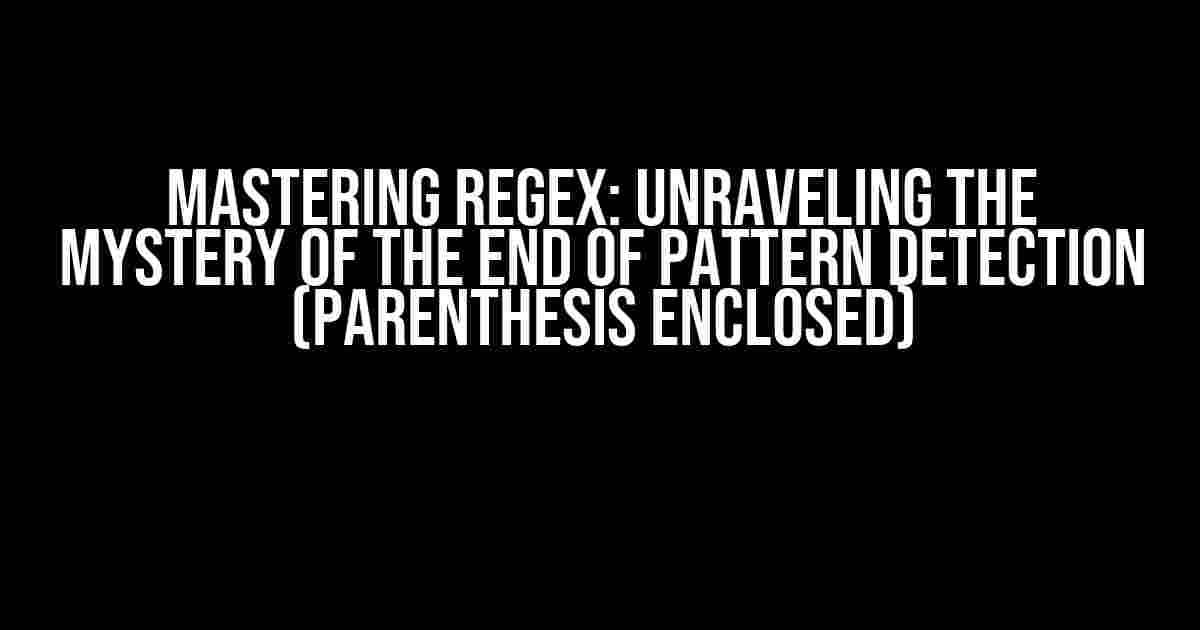Regex, short for Regular Expressions, is a powerful tool used for pattern matching and string manipulation. It’s a language that allows you to search, validate, and extract data from strings. One of the most crucial concepts in Regex is understanding how to detect the end of a pattern, which is where the Regex atom that refers to the end of the current regex pattern (parenthesis enclosed detection) comes into play. In this article, we’ll dive deep into the world of Regex and explore this fascinating topic.
What is the End of Pattern Detection?
The end of pattern detection is a Regex atom that allows you to match the end of a pattern or string. It’s represented by the dollar sign ($) and is used to indicate the end of a string or the end of a line. This atom is essential when you need to ensure that a pattern is matched only at the end of a string, rather than anywhere within the string.
Why is End of Pattern Detection Important?
End of pattern detection is crucial in various scenarios, such as:
- Validating input data: When building a web application, you often need to validate user input data to ensure it meets specific criteria. End of pattern detection helps you validate data by checking if it matches a specific pattern at the end of a string.
- Data extraction: Regex is commonly used for data extraction, and end of pattern detection enables you to extract data from the end of a string or a line.
- String manipulation: End of pattern detection allows you to perform string manipulation tasks, such as trimming or removing unwanted characters from the end of a string.
How to Use End of Pattern Detection (Parenthesis Enclosed)
To use end of pattern detection, you need to enclose the pattern you want to match in parentheses and add the dollar sign ($) at the end. The syntax looks like this:
(pattern)$The parentheses create a capture group, which allows you to group a part of the pattern and refer to it later. The dollar sign ($) indicates the end of the string or line.
Examples of End of Pattern Detection
| Pattern | Description |
|---|---|
(hello)$ |
Matches the string “hello” only if it’s at the end of a string. |
(https?://[^ ]+)$ |
Matches a URL that ends with a space character. |
(\d{4})$ |
Matches a string that ends with a 4-digit number. |
Common Use Cases for End of Pattern Detection
Here are some common use cases for end of pattern detection:
- Validating file extensions: You can use end of pattern detection to validate file extensions, such as ensuring that a file name ends with “.txt” or “.jpg”.
- Extracting domain names: You can use end of pattern detection to extract domain names from URLs, such as extracting “example.com” from “https://www.example.com”.
- Matching trailing characters: You can use end of pattern detection to match trailing characters, such as ensuring that a string ends with a specific set of characters.
Tips and Tricks for End of Pattern Detection
Here are some tips and tricks to keep in mind when using end of pattern detection:
- Use the multiline flag: When working with multiline strings, make sure to use the multiline flag (?m) to enable line-by-line matching.
- Avoid using the $ anchor alone: Using the $ anchor alone can lead to unexpected results, as it can match the end of a line or the end of a string. Always use it in conjunction with a pattern.
- Test your patterns: Always test your Regex patterns thoroughly to ensure they’re matching the desired output.
Conclusion
In conclusion, the Regex atom that refers to the end of the current regex pattern (parenthesis enclosed detection) is a powerful tool that allows you to match the end of a pattern or string. By mastering this concept, you can create more efficient and effective Regex patterns that help you achieve your goals. Remember to use the $ anchor in conjunction with a pattern, and don’t be afraid to experiment and test your patterns to ensure they’re working as expected.
Final Tips and Resources
Here are some final tips and resources to help you improve your Regex skills:
- Practice makes perfect: The more you practice using Regex, the better you’ll become at creating efficient patterns.
- Use online Regex tools: There are many online Regex tools, such as Regex101, that allow you to test and debug your patterns.
- Read Regex documentation: Read the official Regex documentation for your programming language of choice to learn more about the syntax and features.
By following the tips and tricks outlined in this article, you’ll be well on your way to becoming a Regex master. Happy coding!
Frequently Asked Question
Get your regex queries resolved with our expert answers!
What is the regex atom that refers to the end of the current regex pattern?
$ is the regex atom that refers to the end of the current regex pattern. It ensures that the preceding pattern is matched at the end of the string.
How do I use the regex atom to match a pattern at the end of a string?
To match a pattern at the end of a string, simply add the $ atom at the end of your regex pattern. For example, the regex pattern hello$ would match the string “hello” only if it appears at the end of the input string.
Can I use the regex atom with parentheses to capture groups?
Yes, you can use the regex atom with parentheses to capture groups. The $ atom can be used inside or outside of capturing groups. For example, the regex pattern (hello)$ would capture the group “hello” if it appears at the end of the input string.
What is the difference between $ and \z in regex?
While both $ and \z match the end of a string, the key difference is that $ also matches before a newline at the end of a string, whereas \z only matches at the very end of a string, without considering newlines. Use $ when you want to match before newlines, and \z when you want to match exactly at the end of the string.
Can I use the regex atom to match multiple strings at the end of an input string?
Yes, you can use the regex atom with the OR operator (|) to match multiple strings at the end of an input string. For example, the regex pattern (hello|world|foo)$ would match if any of the strings “hello”, “world”, or “foo” appear at the end of the input string.


